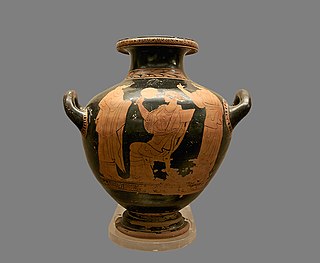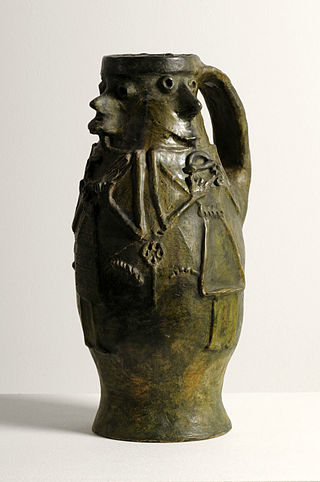
Stoneware is a broad term for pottery fired at a relatively high temperature. A modern definition is a vitreous or semi-vitreous ceramic made primarily from stoneware clay or non-refractory fire clay. End applications include tableware, decorative ware such as vases.

English delftware is tin-glazed pottery made in the British Isles between about 1550 and the late 18th century. The main centres of production were London, Bristol and Liverpool with smaller centres at Wincanton, Glasgow and Dublin. English tin-glazed pottery was called "galleyware" or "galliware" and its makers "gallypotters" until the early 18th century; it was given the name delftware after the tin-glazed pottery from the Netherlands.

Slipware is pottery identified by its primary decorating process where slip is placed onto the leather-hard (semi-hardened) clay body surface before firing by dipping, painting or splashing. Slip is an aqueous suspension of a clay body, which is a mixture of clays and other minerals such as quartz, feldspar and mica. The slip placed onto a wet or leather-hard clay body surface by a variety of techniques including dipping, painting, piping or splashing. Slipware is the pottery on which slip has been applied either for glazing or decoration. Slip is liquified clay or clay slurry, with no fixed ratio of water and clay, which is used either for joining pottery pieces together by slip casting with mould, glazing or decorating the pottery by painting or dipping the pottery with slip.

Beer has been brewed in England for thousands of years. As a beer brewing country, it is known for top fermented cask beer which finishes maturing in the cellar of the pub rather than at the brewery and is served with only natural carbonation.

Pipe smoking is the practice of tasting the smoke produced by burning a substance, most commonly tobacco or cannabis, in a pipe. It is the oldest traditional form of smoking.

The hydria is a form of Greek pottery from between the late Geometric period and the Hellenistic period. The etymology of the word hydria was first noted when it was stamped on a hydria itself, its direct translation meaning 'jug'.
"Bingo" is an English language children's song and folksong about a farmer’s dog. Additional verses are sung by omitting the first letter sung in the previous verse and clapping or barking the number of times instead of actually saying each letter in the key of D major. Its Roud Folk Song Index number is 589.

Mintons was a major company in Staffordshire pottery, "Europe's leading ceramic factory during the Victorian era", an independent business from 1793 to 1968. It was a leader in ceramic design, working in a number of different ceramic bodies, decorative techniques, and "a glorious pot-pourri of styles - Rococo shapes with Oriental motifs, Classical shapes with Medieval designs and Art Nouveau borders were among the many wonderful concoctions". As well as pottery vessels and sculptures, the firm was a leading manufacturer of tiles and other architectural ceramics, producing work for both the Houses of Parliament and United States Capitol.
Gianduja is one of the masks of the Italian commedia dell'arte, typically representing the town of Turin. Gianduja also became the namesake for a Piedmontese chocolate preparation. The mask depicts an honest peasant of Piedmontese country land, with a certain inclination for wine, gastronomy and beautiful girls, while strictly faithful to his lover Giacometta, who is usually represented by a cute girl.

Variety Unit is an exhibit building at Shelburne Museum in Shelburne, Vermont.

A face jug is a jug pottery that depicts a face. There are examples in the pottery of ancient Greece, and that of Pre-Columbian America. Early European examples date from the 13th century, and the German stoneware Bartmann jug was a popular later medieval and Renaissance form. Later, the British Toby Jug was a popular form, that became mass-produced. Especially in America, a number of modern craft potters make pieces, mostly continuing the 19th-century African-American slave folk art tradition.
Charles John Noke, was an English pottery designer and artist who primarily worked for Royal Doulton.

The Smoker is an oil-on-panel painting by the Dutch Golden Age painter Frans Hals, painted in 1626 and now in the Metropolitan Museum of Art, New York City.
In cricket in the early 1760s, there was an evolutionary transition from the sport's "pioneering phase" to its "pre-modern phase" when bowlers began to bowl pitched deliveries by pitching the ball towards the wicket instead of rolling or skimming it along the ground as they had previously done. The essential bowling action was still underarm but the introduction of a ball travelling through the air coupled with a bounce was a key point of evolution in the sport's history, especially as it was the catalyst for the invention of the straight bat, which replaced the old "hockey stick" design. It was the first of three keypoint evolutions in bowling: the others were the introduction of the roundarm style in the 1820s and overarm in the 1860s.

The Wood family was an English family of Staffordshire potters. Among its members were Ralph Wood I (1715–1772), the "miller of Burslem," his son Ralph Wood II (1748–1795), and his grandson Ralph Wood III (1774–1801). Ralph I was the brother of Aaron Wood, father of Enoch Wood. Through his mother, Ralph Wood II was related to Josiah Wedgwood.

The Turner family of potters was active in Staffordshire, England 1756-1829. Their manufactures have been compared favourably with, and sometimes confused with, those of Josiah Wedgwood and Sons. Josiah Wedgwood was both a friend and a commercial rival of John Turner the elder, the first notable potter in the family.
Beer in Sussex is beer produced in the historic county of Sussex in England, East Sussex and West Sussex..

Burton ale is a type of strong ale which is dark and sweet. It is named after the brewing town of Burton-on-Trent.

The pew group is a rare type of pottery Staffordshire figure, apparently made only in the 1740s. Typically it has two or three "rigidly posed" figures sitting on a high-backed bench, often with a woman in the centre; great attention is paid to details of hair and clothing. The setting is not church, as the usual name suggests, but a comfortable home or inn, where high-backed settles were a common piece of furniture. Details are picked out in dark brown or black glaze, and dogs and musical instruments may be depicted, or the gentlemen may be taking snuff.

The original Castleford Pottery operated from c. 1793 to 1820 in Castleford in Yorkshire, England. It was owned by David Dunderdale, and is especially known for making "a smear-glazed, finely moulded, white stoneware". This included feldspar, giving it a degree of opacity unusual in a stoneware. The designs typically included relief elements, and edges of the main shape and the panels into which the body was divided were often highlighted with blue overglaze enamel. Most pieces were teapots or accompanying milk jugs, sugar bowls and slop bowls, and the shapes often derived from those used in contemporary silversmithing.
















